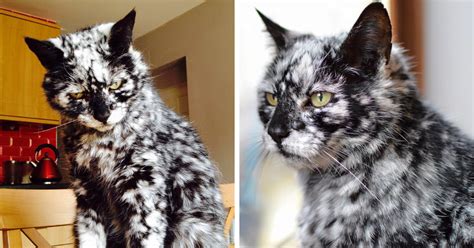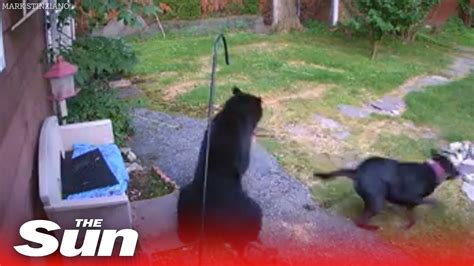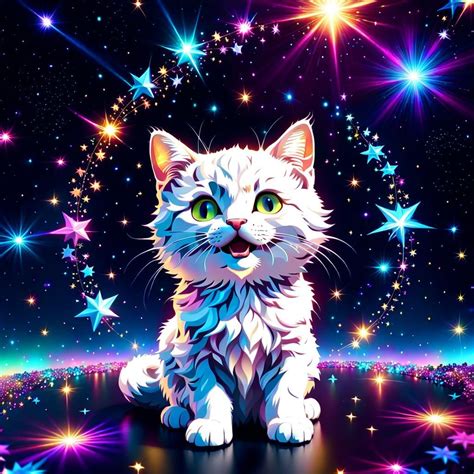
A black cat named Stardust is captivating hearts online due to vitiligo, a rare skin condition causing her sleek, dark fur to transform into a mesmerizing “glittering” coat of white spots.
Stardust, a feline residing in Frankfurt, Germany, has become an internet sensation as her vitiligo progresses, creating a unique and ever-changing appearance that resembles a starry night sky. Her owner, who prefers to remain anonymous, documents Stardust’s transformation on social media platforms like Instagram (@stardust_vitiligocat), where the cat has amassed a significant following eager to witness her evolving beauty.
Vitiligo is a long-term skin condition characterized by the loss of melanocytes, the cells responsible for producing melanin, the pigment that gives skin, hair, and eyes their color. This loss of pigment results in the appearance of white patches on various parts of the body. While vitiligo is more commonly recognized in humans, it can also occur in animals, including cats.
In Stardust’s case, the vitiligo manifests as small, scattered white spots that gradually expand and merge, creating a distinctive pattern across her black fur. The contrast between the dark fur and the white patches gives the impression of shimmering stardust, hence her fitting name.
According to Stardust’s owner, the first signs of vitiligo appeared when Stardust was around one year old. Initially, a few small white spots were noticeable, but over time, the condition progressed, leading to the striking appearance she sports today. The owner emphasizes that despite her unique appearance, Stardust is a healthy and happy cat.
“She’s a very happy cat, she doesn’t know any different,” her owner told Yahoo Lifestyle. “Her vitiligo doesn’t bother her at all.”
Veterinarians confirm that vitiligo is not typically associated with any pain or discomfort in animals. It is a cosmetic condition that primarily affects the animal’s appearance. However, it’s essential for pet owners to consult with a veterinarian to rule out any underlying medical conditions that may be contributing to the pigment loss.
The exact cause of vitiligo remains unknown, but it is believed to be an autoimmune disorder, where the body’s immune system mistakenly attacks and destroys melanocytes. Genetic factors may also play a role in the development of vitiligo. There is no known cure for vitiligo, but various treatments, such as light therapy and topical medications, may help to slow down the progression of the condition or restore some pigment to the affected areas. However, these treatments are more commonly used in humans and are not always effective or practical for animals.
Stardust’s story has resonated with many people who appreciate her unique beauty and see her as a symbol of acceptance and embracing differences. Her owner hopes that Stardust’s story will raise awareness about vitiligo and promote a message of inclusivity and celebrating individuality.
“I think it’s important to show people that different is beautiful,” her owner said. “She’s just a normal cat, she just looks a little different.”
Stardust’s popularity also highlights the growing trend of pet owners sharing their animals’ unique stories and characteristics on social media. These platforms provide a space for pet lovers to connect, share experiences, and celebrate the special bond they share with their animal companions. In many cases, these pets become internet celebrities, capturing the hearts of millions with their adorable antics, heartwarming stories, and unique appearances.
The rise of pet influencers has also created new opportunities for pet-related businesses and organizations to reach a wider audience and promote their products and services. Pet influencers can collaborate with brands to create sponsored content, participate in marketing campaigns, and raise awareness about important animal welfare issues.
Stardust’s story serves as a reminder that beauty comes in many forms and that embracing our differences is what makes us unique and special. Her “glittering” coat is a testament to the fact that even imperfections can be beautiful and that every individual, whether human or animal, has something unique to offer the world.
In-Depth Analysis and Expanded Context
The phenomenon of Stardust the cat and her viral popularity touches upon several broader trends and issues. These include the increasing awareness and understanding of dermatological conditions like vitiligo, the power of social media in shaping perceptions of beauty and normalcy, and the growing role of pets in our lives as sources of emotional support and online entertainment.
-
Vitiligo Awareness: Stardust’s case helps to demystify vitiligo, which, despite affecting a significant portion of the human population, is still often misunderstood. Seeing the condition in an animal can make it more approachable and less stigmatized, fostering empathy and understanding for those who live with it. The fact that Stardust is otherwise a healthy and happy cat reinforces the message that vitiligo is primarily a cosmetic condition and does not necessarily impact overall well-being.
-
Social Media and Beauty Standards: Social media platforms like Instagram often perpetuate unrealistic beauty standards, leading to feelings of insecurity and inadequacy. However, Stardust’s popularity demonstrates that there is also a strong desire for authenticity and uniqueness. Her “glittering” coat, which would traditionally be considered an imperfection, is celebrated and admired, challenging conventional notions of beauty. This can have a positive impact on individuals who may feel self-conscious about their own differences.
-
The Human-Animal Bond: The bond between humans and animals has always been strong, but social media has amplified this connection. Pets are increasingly seen as members of the family, and their lives are documented and shared online. Stardust’s owner’s dedication to showcasing her cat’s beauty and personality resonates with many pet owners who feel a similar sense of pride and affection for their animals. This trend also highlights the therapeutic benefits of pet ownership, as pets provide companionship, emotional support, and unconditional love.
-
Pet Influencers and the Pet Economy: Stardust’s popularity is part of a larger trend of “pet influencers” who have amassed large followings on social media. These pets can generate significant income through sponsorships, endorsements, and merchandise sales. The pet economy is a multi-billion dollar industry, and pet influencers play a growing role in shaping consumer behavior and promoting pet-related products and services. This also raises ethical considerations about the commercialization of animals and the potential for exploitation.
-
Scientific Understanding of Vitiligo: While Stardust’s story is primarily focused on her unique appearance, it also provides an opportunity to delve deeper into the scientific understanding of vitiligo. Research into the causes and potential treatments of vitiligo is ongoing, and advancements in immunology and genetics are providing new insights into the condition. Understanding the underlying mechanisms of vitiligo could lead to more effective therapies for both humans and animals.
-
Ethical Considerations in Pet Ownership: Stardust’s case also prompts reflection on ethical considerations in pet ownership. While Stardust’s owner emphasizes that her vitiligo does not bother her, it is important to be mindful of the potential impact of cosmetic conditions on an animal’s well-being. Owners have a responsibility to ensure that their pets are healthy, comfortable, and free from unnecessary suffering. In cases where a cosmetic condition is associated with pain or discomfort, treatment should be prioritized over aesthetic considerations.
Comparison to Other Cases of Vitiligo in Animals
Stardust is not the only animal to have captured attention due to vitiligo. There have been other documented cases of vitiligo in various species, including dogs, horses, and even birds. Each case is unique, and the extent and pattern of pigment loss can vary significantly.
-
Rowdy the Dog: Rowdy, a black Labrador retriever, gained internet fame for his vitiligo, which caused white patches to appear around his eyes, giving him a distinctive masked appearance. Rowdy’s owner used his platform to raise awareness about vitiligo and to promote acceptance and inclusion.
-
Horses with Vitiligo: Vitiligo in horses can manifest as white patches on the skin and hair, particularly around the muzzle and eyes. The condition is more noticeable in horses with dark coats. While vitiligo does not typically affect a horse’s health or performance, it can be a cosmetic concern for some owners.
-
Birds with Vitiligo: Vitiligo can also occur in birds, causing white feathers to appear in otherwise colorful plumage. The condition is more common in certain bird species, such as crows and magpies. Vitiligo in birds can sometimes affect their ability to attract mates or camouflage themselves from predators.
Comparing these cases highlights the diversity of vitiligo’s presentation in different species and the varying impacts it can have on an animal’s life. While vitiligo is generally considered a cosmetic condition, it is important to be aware of the potential psychological and social implications for both animals and their owners.
The Future of Stardust’s Online Presence
Stardust’s online presence is likely to continue to grow as her vitiligo progresses and her story reaches a wider audience. Her owner has the opportunity to use her platform to further promote awareness about vitiligo, advocate for animal welfare, and share positive messages about embracing differences.
Potential avenues for expanding Stardust’s online presence include:
- Collaborations with animal welfare organizations: Partnering with animal shelters or rescue groups to raise awareness about adoption and responsible pet ownership.
- Creating merchandise featuring Stardust’s image: Selling products such as t-shirts, mugs, and phone cases to generate income and promote her message.
- Writing a children’s book about Stardust: Sharing her story with young readers to teach them about acceptance and celebrating individuality.
- Participating in public appearances and events: Attending pet expos or charity events to meet fans and raise awareness about vitiligo.
By leveraging her online platform, Stardust’s owner can create a lasting impact and inspire others to embrace their own unique qualities.
Conclusion
Stardust the cat’s story is more than just a heartwarming tale about a pet with a unique appearance. It is a reflection of broader societal trends related to beauty standards, social media, and the human-animal bond. Her “glittering” coat serves as a reminder that beauty comes in many forms and that embracing our differences is what makes us unique and special. As Stardust’s online presence continues to grow, she has the potential to inspire others to accept themselves and to celebrate the beauty of imperfection. The increased awareness of vitiligo and the positive messages promoted through her platform can contribute to a more inclusive and compassionate world for both humans and animals. Furthermore, understanding the underlying science of vitiligo and promoting ethical pet ownership practices are essential components of this narrative. Stardust’s lasting legacy will depend on her owner’s commitment to using her platform responsibly and to advocating for causes that align with her message of acceptance and celebration of individuality.
Frequently Asked Questions (FAQ)
-
What is vitiligo in cats? Vitiligo in cats is a skin condition characterized by the loss of melanocytes, the cells that produce pigment, resulting in white patches on the skin and fur. According to the article, “Vitiligo is a long-term skin condition characterized by the loss of melanocytes… This loss of pigment results in the appearance of white patches on various parts of the body.”
-
Is vitiligo harmful to cats? No, vitiligo is generally not harmful to cats and is considered a cosmetic condition. Stardust’s owner states, “She’s a very happy cat, she doesn’t know any different. Her vitiligo doesn’t bother her at all.” Veterinarians confirm that it typically doesn’t cause pain or discomfort.
-
What causes vitiligo in animals like Stardust? The exact cause is unknown, but it’s believed to be an autoimmune disorder where the body’s immune system attacks melanocytes. Genetic factors may also play a role. The article mentions, “The exact cause of vitiligo remains unknown, but it is believed to be an autoimmune disorder… Genetic factors may also play a role.”
-
Are there any treatments for vitiligo in cats? There is no known cure for vitiligo, and treatments are not typically pursued in animals as the condition is cosmetic. While treatments like light therapy and topical medications exist for humans, they are not always practical or effective for animals.
-
How did Stardust get her name? Stardust received her name because the white patches caused by vitiligo on her black fur resemble shimmering stardust, creating the impression of a starry night sky. The article explains, “The contrast between the dark fur and the white patches gives the impression of shimmering stardust, hence her fitting name.”









